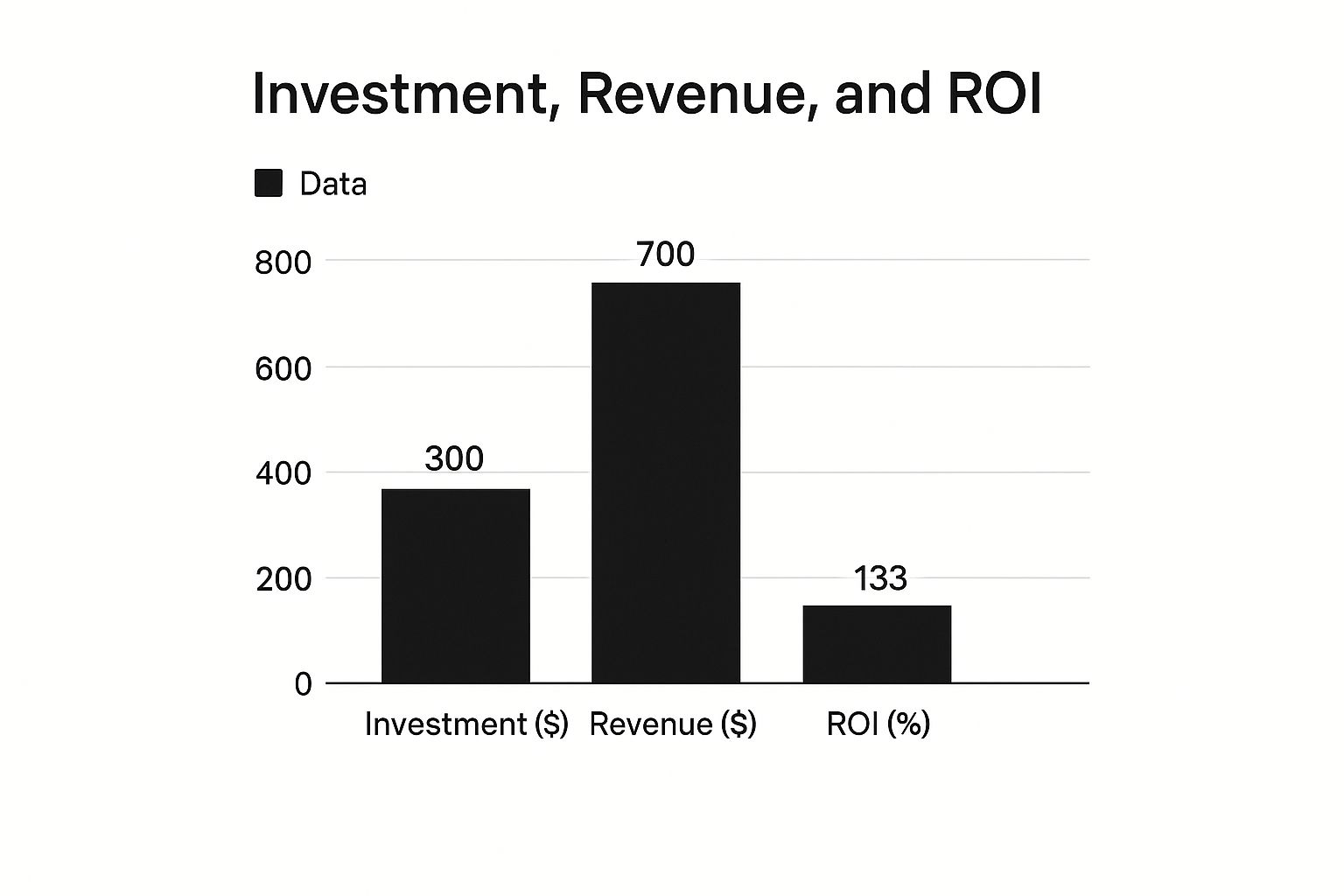Understanding SEO ROI: Beyond Rankings and Traffic

Calculating SEO ROI isn't as straightforward as simply checking your website's ranking for a handful of keywords. While ranking improvements are certainly important, focusing solely on rankings, or even traffic, can give you a misleading picture of your SEO's true effectiveness. This is because these metrics don't always correlate directly with business growth.
For instance, your website might rank #1 for a particular keyword. But if that keyword doesn't bring in relevant traffic or lead to conversions, the top ranking itself doesn't offer much value. A broader perspective is essential.
Moving Beyond Vanity Metrics
The real key to understanding SEO ROI lies in linking your SEO activities to tangible business results. This involves shifting your focus from vanity metrics like rankings and traffic to metrics that have a direct impact on your bottom line: leads, conversions, sales, and ultimately, revenue.
It's also crucial to consider the long-term impact of SEO. Unlike paid advertising, SEO is a long-term investment that generates compounding returns over time. The more consistently you invest in SEO, the more valuable your organic traffic becomes.
Connecting SEO to Revenue
Smart marketers recognize the importance of directly connecting SEO performance to revenue metrics. This connection enables them to accurately assess the effectiveness of their SEO strategies and validate ongoing investment in SEO initiatives.
This process involves accurately tracking which keywords and landing pages drive conversions and assigning a monetary value to those conversions. You might use conversion tracking in Google Analytics or other analytics platforms like That's Rank to monitor keyword performance and website traffic.
This granular tracking reveals how much revenue each keyword generates, enabling you to prioritize high-performing keywords and refine your SEO strategy for maximum impact. This data also helps you precisely calculate your SEO ROI and demonstrate the financial benefits of SEO to stakeholders.
The growth of the global SEO market underscores the rising importance of SEO in digital marketing. The market is expected to reach $146.96 billion by 2025 and is projected to expand at a CAGR of 8.3% from 2024 to 2030.
This growth is fueled by the high ROI that SEO offers, especially for e-commerce businesses. The average ROI for SEO in e-commerce can range from 700% to 900%. Furthermore, SEO can lead to a 60% lower Customer Acquisition Cost (CAC) compared to non-organic channels. More detailed statistics are available here: https://aioseo.com/seo-statistics/. This data clearly illustrates the financial potential of a well-executed SEO strategy.
Demonstrating SEO Value
By connecting SEO performance to concrete business outcomes and emphasizing revenue-driven metrics, you can effectively showcase the true value of SEO to stakeholders. This helps you secure buy-in for future SEO investments and ultimately drive sustainable business growth through organic search. This lays the foundation for a robust and financially successful SEO strategy. The next critical step is understanding the specific metrics that are most relevant for calculating SEO ROI.
The Essential Metrics That Actually Matter for SEO ROI
Calculating SEO ROI can be tricky. While surface-level metrics like keyword rankings and overall traffic offer a glimpse into performance, they don't reveal the complete picture. To truly grasp the return on your SEO investment, it's essential to focus on metrics directly linked to revenue. This means prioritizing data that showcases the real impact of your SEO efforts on your bottom line.
Key Metrics for Calculating SEO ROI
Here are the key metrics that truly matter when measuring the effectiveness of your SEO strategy:
- Leads: Track how many leads originate from organic search. This requires pinpointing the keywords and landing pages that are driving those leads, enabling you to refine your SEO strategy for maximum lead generation.
- Conversion Rate: This vital metric reveals the percentage of organic traffic that converts into valuable actions, such as purchases, form submissions, or newsletter sign-ups. A higher conversion rate signals a more effective SEO approach.
- Sales: For e-commerce businesses, tracking sales directly attributable to organic search is paramount. By linking specific keywords and landing pages to sales data, you can pinpoint the SEO activities with the greatest revenue impact.
- Average Order Value (AOV): This metric measures the average amount spent per order by customers arriving through organic search. Increasing your AOV can substantially boost your overall SEO ROI.
- Customer Lifetime Value (CLV): This metric predicts the total revenue expected from a customer acquired through organic search throughout their relationship with your business. Understanding CLV helps inform long-term SEO investment decisions.
- Revenue: This is the ultimate measure of SEO success. By tracking revenue generated through organic search, you can accurately calculate your SEO ROI and showcase the financial value of your efforts. Learn more about measuring SEO performance with these SEO Performance Metrics.
SEO ROI statistics often highlight the efficiency of SEO in comparison to traditional marketing strategies. For example, SEO boasts an average conversion rate of 14.6%, significantly surpassing traditional outbound methods, which have a conversion rate of just 1.7%. Businesses typically see an average revenue increase of 2.8% from their SEO investments. You can explore more SEO ROI statistics.
Visualizing SEO ROI
To better understand how investment, revenue, and ROI interact within an SEO campaign, consider the following infographic:

This infographic illustrates how a well-executed SEO strategy can generate substantial returns. By diligently monitoring investment, revenue, and the resulting ROI, you can make data-driven decisions to further optimize your approach. Understanding different levels of security investments and their corresponding outcomes is also vital for demonstrating ROI. Reviewing basic security measures can be beneficial. Furthermore, measuring the ROI of individual SEO campaigns or specific tactics helps you identify and prioritize the most effective efforts. This leads to more efficient resource allocation and a higher overall return on investment.
To further illustrate the importance of various metrics in calculating SEO ROI, let's examine the following table:
Critical SEO ROI Metrics Comparison
This table compares essential metrics for calculating SEO ROI, showing which metrics provide the most accurate picture of performance and why.
| Metric | What It Measures | Importance to ROI Calculation | Common Measurement Pitfalls |
|---|---|---|---|
| Leads | Number of potential customers generated from organic search | Indicates potential for future revenue | Attributing leads solely to SEO without considering other channels |
| Conversion Rate | Percentage of organic traffic that completes a desired action | Demonstrates the effectiveness of SEO in driving desired outcomes | Focusing on overall conversion rate without segmenting by traffic source |
| Sales | Direct revenue generated from organic search | Provides a clear link between SEO and financial performance | Difficulty isolating sales solely attributed to organic search |
| Average Order Value (AOV) | Average amount spent per order from organic search customers | Shows the impact of SEO on revenue per customer | Fluctuations in AOV due to seasonal factors or promotions |
| Customer Lifetime Value (CLV) | Predicted total revenue from an organic search customer | Helps assess the long-term value of SEO investments | Difficulty in accurately predicting future customer behavior |
| Revenue | Total income generated from organic search traffic | The ultimate measure of SEO success | Accurately attributing revenue to specific SEO efforts |
By considering these metrics and their potential pitfalls, you can gain a comprehensive understanding of your SEO ROI and refine your strategies to maximize returns. Focusing on the metrics directly linked to revenue will paint a clearer picture of your SEO performance and allow for data-driven optimization.
Your Step-by-Step Framework to Calculate SEO ROI

Calculating your SEO ROI isn't about guesswork. It's about understanding the real financial impact of your SEO strategy. This section offers a practical, repeatable framework for calculating SEO ROI, adaptable for businesses of all sizes. This provides a clear system for measuring the return on your SEO investment.
Step 1: Establish Your SEO Investment Baseline
First, determine all costs related to your SEO activities. This includes obvious costs such as Semrush subscriptions or agency fees. Also, include less obvious costs, such as content creation, technical SEO improvements, and the time your internal team dedicates to SEO tasks. Overlooking these hidden costs can significantly impact your ROI calculations.
- Direct Costs: SEO agency fees, software subscriptions, freelancer payments.
- Indirect Costs: Content creation, technical SEO improvements, internal team time.
Accurately tracking all SEO-related expenses provides a true baseline for your investment. This comprehensive cost analysis is crucial for calculating a realistic ROI.
Step 2: Assign Monetary Value to Organic Traffic and Conversions
Next, determine the monetary value generated by organic traffic. This depends on your business model. For e-commerce businesses, directly track sales from organic search. For lead generation businesses, calculate the average value of a lead and multiply it by the number of leads generated through organic search.
For content-driven sites, measure the impact of organic traffic on business goals, such as newsletter signups or free trial activations. Assign a monetary value to these conversions based on their contribution to your overall revenue. To gain a comparative perspective on how strategic investments translate into tangible outcomes, consider exploring the article about the ROI of AI in customer service.
Step 3: Apply the SEO ROI Formula
With your investment and return figures defined, use this formula to calculate your SEO ROI:
SEO ROI = [(Revenue from SEO - SEO Costs) / SEO Costs] x 100
For example, if you invested $5,000 in SEO and generated $25,000 in revenue, your ROI is:
SEO ROI = [($25,000 - $5,000) / $5,000] x 100 = 400%
This means that for every dollar invested in SEO, you generated four dollars in revenue. This calculation clearly demonstrates the financial effectiveness of your SEO strategy.
Step 4: Refine and Iterate
SEO is an ongoing process. Regularly monitor your SEO ROI and adapt your strategy accordingly. This iterative approach allows you to continually optimize your approach and maximize returns. Identify which SEO activities deliver the highest ROI and allocate your resources strategically. Research indicates SEO can achieve an ROI as high as 1,389% over three years, with an average of around 900% across 15+ industries.
Practical Considerations for Different Business Models
Different business models require tailored approaches to calculating SEO ROI. Here's a breakdown:
- E-commerce: Track revenue generated directly from organic search traffic.
- Lead Generation: Calculate the value of each lead and multiply it by the number of organic search leads.
- Content-Driven Businesses: Measure the impact of organic traffic on key goals like newsletter sign-ups or free trial activations.
By adapting your ROI calculations to your specific business model, you can gain more precise insights and make informed decisions. This focused approach will help you maximize returns on your SEO investments.
The Time Factor: Capturing SEO's Compounding Returns
Unlike paid advertising, which delivers immediate but temporary results, SEO is a long-term investment. It offers compounding returns over time, a crucial factor when calculating SEO ROI. This means the value of your SEO efforts increases the longer you maintain them.
Understanding SEO's Long-Term Growth
Think of SEO like planting a tree. Initially, you invest time and resources in preparing the soil and nurturing the sapling. You won’t see immediate fruit. But with consistent care, the tree grows stronger and eventually bears more and more fruit each year. Similarly, SEO requires ongoing effort and patience.
SEO investments mature and compound in value. Initial efforts may yield modest gains. However, consistent, high-quality SEO builds a strong foundation for long-term success. This sustained effort leads to improved rankings, increased traffic, and ultimately, higher conversions and revenue.
Additionally, calculating SEO ROI involves understanding the long-term benefits of SEO campaigns. A positive ROI in an SEO campaign is typically achieved over a period of 6 to 12 months, with peak results often observed in the second or third year. This makes SEO a strategic investment requiring patience and consistent effort. Find more detailed statistics here.
Realistic Timelines and Benchmarks
The timeline for seeing a return on your SEO investment varies based on factors like industry competitiveness and keyword difficulty. Highly competitive industries may require more time and effort to see significant results. However, the long-term benefits of ranking for competitive keywords can be substantial.
Progressive ROI Models
Because SEO results unfold over time, it’s essential to develop progressive ROI models. These models should align with the different maturity stages of your SEO program.
In the initial stages, focus on metrics like keyword rankings and organic traffic growth. As your SEO matures, shift your focus to conversion rates, leads, and revenue generated from organic search.
To help set realistic expectations, let's look at a typical SEO ROI timeline:
The following table shows typical SEO ROI outcomes across different timeframes, helping set realistic expectations for when positive returns can be expected.
| Time Period | Typical ROI Range | Key Performance Indicators | Investment Considerations |
|---|---|---|---|
| 3-6 Months | Minimal - Moderate | Increased brand visibility, improved keyword rankings, growing organic traffic | Content creation, technical SEO improvements, initial link building |
| 6-12 Months | Moderate - Substantial | Significant traffic growth, rising conversions, noticeable lead generation | Ongoing content marketing, advanced link building, conversion rate optimization |
| 12+ Months | Substantial - High | Dominating SERPs for target keywords, sustained lead flow, significant revenue growth | Content expansion, authority building, ongoing CRO and analytics |
This table demonstrates how SEO ROI grows over time. While initial results may be modest, consistent effort yields significant long-term gains.
Forecasting Future Returns
Forecasting future SEO ROI is crucial for demonstrating the long-term value of your SEO strategy. By analyzing early indicators like keyword ranking improvements and traffic growth, you can project future returns and justify ongoing investment. Tools like That's Rank can be instrumental in tracking these early indicators and providing data-driven forecasts.
Communicating Long-Term Value
One of the biggest challenges in demonstrating the value of SEO is communicating its long-term nature to stakeholders who may be focused on short-term gains. Educating stakeholders about SEO’s compounding returns and the importance of sustained investment is critical for securing ongoing support for your SEO initiatives. By showcasing the long-term potential of SEO, you can justify the required resources and demonstrate the strategic value of organic search for sustainable business growth.
Advanced Techniques to Precisely Calculate SEO's Impact

Calculating basic SEO ROI is a good starting point. However, to truly understand its impact, more advanced techniques are needed. These techniques provide deeper performance insights and inform better decision-making. This section explores those advanced methods.
Isolating SEO's Contribution in Multi-Channel Environments
Customers rarely interact with just one channel before converting. They might discover your business through organic search, engage with social media, click a paid ad, and finally purchase via email. This makes isolating SEO's contribution a challenge.
Advanced attribution modeling helps address this. Instead of crediting only the last click, attribution models distribute credit across all customer journey touchpoints. This gives a more accurate view of SEO's contribution, even when it's not the final interaction.
For example, a linear attribution model assigns equal credit to all touchpoints. A time decay model favors touchpoints closer to the conversion. Choosing the right model depends on your business and customer journey.
Cohort Analysis for Long-Term SEO Value
Cohort analysis groups customers with shared characteristics (like acquisition date) and tracks their behavior over time. This technique is valuable for understanding the long-term value of customers acquired through SEO. You may be interested in learning more about SEO strategy.
For instance, you might analyze the revenue from customers acquired through organic search in January compared to February. This reveals how customer value changes over time, offering insights into customer retention and the long-term effects of SEO efforts.
Incrementality Testing and Predictive Modeling
Incrementality testing uses controlled experiments to determine the incremental impact of SEO. By comparing performance with and without specific SEO activities, it proves SEO's unique contribution. This is especially valuable in complex multi-channel scenarios.
Predictive modeling uses statistical techniques and historical data to forecast future SEO returns. Identifying data trends and patterns lets you develop models that predict future traffic, conversions, and revenue. This enables data-driven investment decisions and demonstrates SEO strategy potential to stakeholders.
Calculating ROI for Specific SEO Initiatives
ROI calculations can also be applied to specific SEO initiatives, such as technical improvements or content creation. This granular approach helps pinpoint the most profitable activities for more targeted investment.
For example, calculate the ROI of a website migration by comparing the migration cost to the increase in organic traffic and conversions. This demonstrates the project's financial impact. Similarly, measure content marketing ROI by tracking revenue from content created during a specific timeframe. This data-driven approach optimizes resource allocation and maximizes overall SEO ROI.
Key Takeaways for Advanced ROI Measurement
- Attribution modeling provides a more precise understanding of SEO’s role in multi-channel environments.
- Cohort analysis unveils the long-term value of SEO-acquired customers.
- Incrementality testing proves SEO’s unique contribution.
- Predictive modeling forecasts future SEO returns for informed decision-making.
- Calculating ROI for specific SEO initiatives enables targeted investment strategies.
By applying these advanced techniques, you’ll gain a deeper understanding of SEO performance and unlock the full potential of organic search.
Avoiding The Fatal Flaws In SEO ROI Calculation
Calculating SEO ROI can be tricky, and even experienced marketers sometimes make mistakes. Overlooking key factors can significantly distort your results, leading to an inaccurate view of your SEO performance. This section helps you identify and fix these common pitfalls.
Attribution Blind Spots: Seeing The Whole Picture
One of the biggest challenges is attribution. SEO is often not the last point of contact before a conversion. A customer might find your business through organic search, then interact with social media or email marketing before finally purchasing. Attributing the conversion solely to the last click ignores SEO's crucial initial role.
To address this, consider multi-touch attribution models. These models distribute credit across every touchpoint in the customer journey. This provides a more complete understanding of how SEO contributes to conversions, even when it's not the final interaction. Tools like That's Rank offer features to help track these complex customer journeys.
The Customer Lifetime Value Conundrum
Another common mistake is undervaluing customer lifetime value (CLV). Focusing only on immediate conversions ignores the long-term value of customers acquired through organic search. These customers might make repeat purchases or become brand advocates, generating revenue far beyond their first conversion.
To calculate SEO ROI accurately, factor in CLV. Estimate the total revenue a customer acquired through SEO is likely to generate throughout their relationship with your business. This provides a more holistic understanding of SEO's long-term impact.
Beyond The Monetary: The Hidden Value of SEO
SEO generates value beyond direct revenue. Increased brand visibility, improved website authority, and valuable user data are important benefits often overlooked in ROI calculations. While these might not have an immediate monetary value, they significantly contribute to long-term business growth.
Consider incorporating these non-monetary benefits into your ROI analysis. For instance, assign a value to increased brand awareness based on its potential to drive future conversions.
The Time Trap: Choosing The Right Timeframe
SEO is a long-term strategy, and using a short timeframe for ROI calculation can be misleading. Initial SEO efforts might not generate significant revenue right away. However, the compounding effects of SEO build over time, leading to substantial returns in the long run.
Choose a timeframe that reflects the long-term nature of SEO. Calculate ROI over 6-12 months, or even longer, to capture the full impact of your SEO strategy. Remember, SEO is a marathon, not a sprint. Don't underestimate its growth potential over an extended period.
Separating SEO Impact From External Factors
Market fluctuations, seasonality, and other marketing campaigns can influence your results, making it difficult to isolate the true contribution of SEO. Failing to account for these external factors can skew your ROI calculations.
Use control groups or statistical analysis to isolate SEO's impact. This helps accurately measure the effectiveness of your SEO strategy, independent of other influences. By carefully analyzing your data and considering external factors, you can ensure your SEO ROI calculations are accurate and reliable. This data then informs better strategic decisions and maximizes your SEO investment returns.
Turning ROI Insights Into Strategic SEO Decisions
The true power of calculating SEO ROI isn't simply seeing a positive number. It's about using those insights to inform strategic decisions that fuel future growth. This means transforming your ROI data into actionable strategies to maximize your organic search performance. Let's explore how leading marketers use these insights to shape their SEO strategies.
Increasing SEO Investment Based on ROI
A strong positive ROI demonstrates the effectiveness of your SEO efforts. This justifies increasing your investment to further amplify your success. For example, if your current SEO strategy generates a 400% ROI, reinvest a portion of those profits to expand your activities.
This might include creating more high-quality content, targeting additional keywords, or investing in advanced SEO tools like That's Rank. Reinvesting profits from successful campaigns creates a cycle of growth, compounding returns over time.
Pivoting Tactics Based on ROI Performance
Conversely, a low or negative ROI indicates your current strategy isn't performing as expected. This signals the need for a tactical shift. Analyze underperforming aspects of your strategy and adjust accordingly.
This could involve revisiting your keyword targeting, optimizing existing content, or exploring new link building strategies. Experiment and iterate until you identify tactics yielding the highest ROI.
Allocating Resources Across Different Search Initiatives
Calculating the ROI of individual SEO initiatives allows for focused resource allocation. You might find that content marketing delivers a significantly higher ROI than technical SEO improvements.
This insight could lead you to allocate more resources to content creation and fewer to technical optimization. This data-driven approach ensures you're investing in the most impactful activities.
Benchmarking SEO ROI Against Other Marketing Channels
Comparing your SEO ROI to other marketing channels, such as paid advertising or social media marketing, allows you to optimize your overall marketing mix. If SEO consistently outperforms other channels, consider shifting more of your budget towards organic search.
However, maintain a diversified marketing portfolio to reach a wider audience and mitigate risk. Learn more in this article about how to master SEO client dashboards.
Using ROI Forecasting for Strategic Planning
Forecasting future SEO ROI is essential for building strong business cases for additional resources. By projecting potential returns from increased SEO investment, you can demonstrate the value of SEO to stakeholders and secure buy-in for expanding your efforts.
This forward-looking approach helps secure the resources needed for long-term SEO success.
Presenting ROI Data to Stakeholders
Effectively communicating your SEO ROI to stakeholders demonstrates the value of your work. Tailor presentations to the specific audience. CEOs are typically interested in the overall business impact, while CFOs focus on financial returns.
Use clear visualizations, like charts and graphs, to present data in an easily digestible format. Highlight key takeaways and explain how your SEO strategy contributes to the company’s overall goals.
By turning ROI insights into strategic actions, you maximize the impact of your SEO efforts and drive sustainable business growth through organic search. This data-driven approach enables informed decisions, optimized resource allocation, and demonstrates the true value of SEO to your organization. Ready to elevate your SEO tracking and ROI calculations? That's Rank! offers a comprehensive platform for tracking keyword rankings, monitoring SERP performance, conducting site audits, and analyzing competitor strategies, empowering you to make data-driven decisions and maximize your SEO ROI. Visit That's Rank! today to start your free trial.